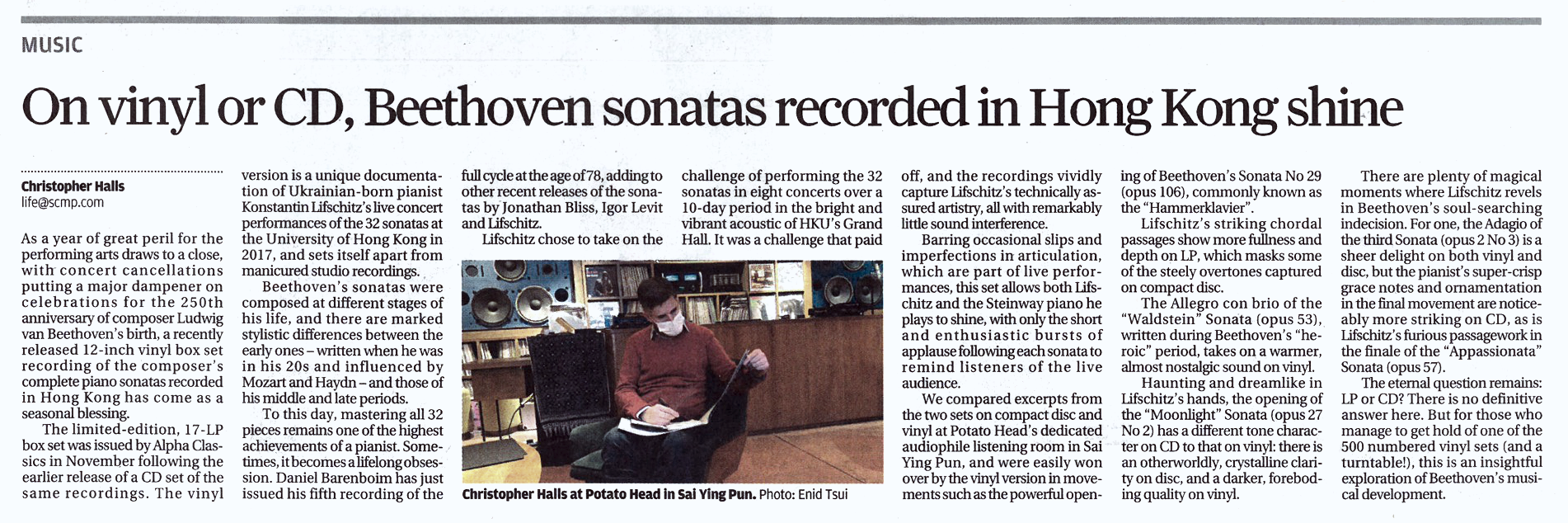南華早報 South China Morning Post
30 DEC 2020

As a year of great peril for the performing arts draws to a close, with concert cancellations putting a major dampener on celebrations of the 250th anniversary of composer Ludwig van Beethoven’s birth, a recently released 12-inch vinyl box set recording of the composer’s complete piano sonatas recorded in Hong Kong has come as a seasonal blessing.
The limited-edition, 17-LP box set was issued by Alpha Classics in November following the earlier release of a CD set of the same recordings. The vinyl version is a unique documentation of Ukrainian-born pianist Konstantin Lifschitz’s live concert performances of the 32 sonatas at the University of Hong Kong in 2017, and sets itself apart from manicured studio recordings of the works.
Beethoven’s sonatas were composed at different stages of his life, and there are marked stylistic differences between the early ones – written when he was in his 20s and influenced by fellow composers Mozart and Haydn – and those of his middle and late periods.
To this day, mastering all 32 pieces remains one of the highest achievements of a pianist. Sometimes, it becomes a lifelong obsession. Daniel Barenboim has just issued his fifth recording of the full cycle at the age of 78, adding to other recent releases of the sonatas by Jonathan Bliss, Igor Levit and Lifschitz.
Lifschitz chose to take on the challenge of performing the 32 sonatas in eight concerts over a 10-day period in the bright and vibrant acoustic of HKU’s Grand Hall. It was a challenge that paid off, and the recordings vividly capture Lifschitz’s technically assured artistry, all with remarkably little sound interference.
Barring occasional slips and imperfections in articulation, which are part and parcel of live performances, this set allows both Lifschitz and the Steinway piano he plays to shine, with only the short and enthusiastic bursts of applause following each sonata to remind listeners of the live audience.
We compared excerpts from the two sets on compact disc and vinyl at Potato Head’s dedicated audiophile listening room in Sai Ying Pun, and were easily won over by the vinyl version in movements such as the powerful opening of Beethoven’s Sonata No 29 (opus 106), commonly known as the “Hammerklavier”.
Lifschitz’s striking chordal passages show more fullness and depth on LP, which masks some of the steely overtones and heat-of-the-moment harshness captured on compact disc.
Similarly, the Allegro con brio of the “Waldstein” Sonata (opus 53), written during Beethoven’s “heroic” period, seems to take on a warmer, almost nostalgic sound on vinyl.
Suitably haunting and dreamlike in Lifschitz’s hands, the famous opening of the “Moonlight” Sonata (opus 27 No 2) has a different tone character on CD to that on vinyl: there is an otherworldly, crystalline clarity on disc, and a darker, foreboding quality on vinyl.
There are plenty of magical moments where Lifschitz revels in Beethoven’s soul-searching indecision. For one, the Adagio of the third Sonata (opus 2 No 3) is a sheer delight on both vinyl and disc, but the pianist’s super-crisp grace notes and ornamentation in the final movement are noticeably more striking on CD, as is Lifschitz’s furious passagework in the finale of the “Appassionata” Sonata (opus 57).
Some of the more playful aspects of Beethoven may disappoint, however. In the delightful second movement (the Menuetto) of the little gem that is Sonata No 10 (opus 49 No 2), less earnestness and a good dose of lighthearted, tongue-in-cheek charm wouldn’t have gone amiss.
The eternal question remains: LP or CD? There is no definitive answer here. But for those who manage to get hold of one of the 500 numbered vinyl sets (and a turntable!), this is a thoroughly insightful exploration of Beethoven’s musical development and a unique collection.

